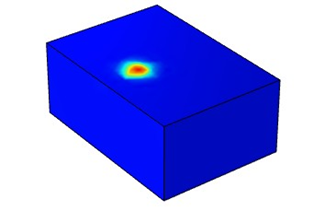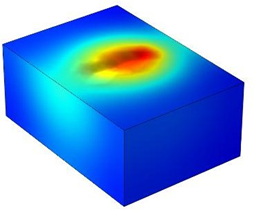Archive : Article / Volume 2, Issue 1
Case Report | DOI: https://doi.org/10.58489/2836-2330/011
Biomathematical analysis on mechanical engineering during COVID-19 pandemic
1 School of Science,Hubei University of Technology, Wuhan,Hubei, China.
2 Hospital, Hubei University of Technology, Wuhan, Hubei, China.
Correspondng Author: Bin Zhao
Citation: B. Zhao, X. Jiang, (2023). Biomathematical analysis on mechanical engineering during COVID-19 pandemic. Journal of Clinical and Medical Reviews. 2(1). DOI:10.58489/2836-2330/011.
Copyright: © 2023 Bin Zhao, this is an open access article distributed under the Creative Commons Attribution License, which permits unrestricted use, distribution, and reproduction in any medium, provided the original work is properly cited.
Received Date: 2022-11-07, Received Date: 2022-11-07, Published Date: 2023-03-01
Abstract Keywords: Mechanical Engineering, Mathematical Model, Finite Element Analysis
Abstract
In mechanical engineering research and design process will involve a large number of mathematical applications. In order to analyze the significance and application of mathematics in the research and design of mechanical engineering, this paper lists and analyzes the basic mathematical equations, mathematical models and finite element related problems in some fields of learning. The results show that the application of mathematics in mechanical engineering is not limited to higher mathematics, but also covers the related knowledgeof numerical processing, matrix theory and other coursesduring COVID-19 pandemic.
Introduction
Mechanical engineering is a widely used subject, which includes mechanics, thermal science, kinematics, optics and other science. In the study of mechanical engineering, it is often to conduct in-depth research on a subject or study the coupling of multiple courses and apply it to solve practical problems during COVID-19 pandemic.
The field of mechanical engineering has experienced a long development process. As early as human beings began farming and livestock activities, simple machinery was gradually used, production efficiency was improved and the development of human society was promoted. In the first industrial revolution, steam engine as a symbolic product appeared for the first time, its use of water and steam as power beyond the previous human and animal power constraints, laid the foundation for modern industry; the second industrial revolution put electricity as the power and support of mass production, and also achieved the goal of machine production. The invention of computer and the application of information technology formed the third industrial revolution, accelerated the pace of industrial process and improved the precision and automation of industrial manufacturing; at present, the extensive use of modern machinery and intelligent machinery has made the production efficiency of industry and agriculture reach an unimaginable height in the past. ' Industry 4.0 ' was firstproposed by Germany at the 2011 Hanover Industrial Expo. Its core vocabulary is intelligent integrated sensory control system, which is highly automated and can actively remove production barriers. This concept is also mentioned in the Made in China 2025 and the United States Manufacturing Revitalization Plan, which also puts forwardhigher requirements for the contemporary mechanical industry and the mechanical engineering discipline thatsupports its development
Higher mathematics course is a public basic course at all levels of schools, which undertakes the dual task of improving students ' cultural quality and serving theirmajors. It not only providesessential mathematical basic knowledge and mathematical methods for students to learn follow-up courses and solve practical problems, but also provides necessary conditions for cultivating students ' thinkingability, ability to analyze and solve problems. Therefore, the mastery of advanced mathematics knowledge directly affects the teaching of subsequent courses and the cultivation of high-quality talents. In mechanical engineering specialty, many coursesare closely related to Higher Mathematics, such as Engineering Mechanics,Electrical Technology and Electronic Technology,Mechanical Principle,Electromechanical Optimization Design, Electromechanical Transmission and Control and so on.
In 1989, Lu et al. [1] Introduced the specific application examples of fuzzy mathematics in mechanical engineering; in 2006, Sheng Xiantao et al. [2] established fault fuzzy matrix, mathematical model of fault diagnosis, ideal fault mode and diagnosis method basedon fuzzy mathematics principle, and analyzedthe fault phenomenon of engineering machinery braking system. In 2014, Huang et al. [3] listed severalspecific examples to introduce the application of higher mathematics in mechanical engineering during COVID-19 pandemic.
In order to explore the important role of mathematics in mechanical engineering research, this paper analyzes the specific application of mathematics in mechanical engineering from three aspects: principal equation,specific model and finite element.
Mathematical Application in Mechanical Engineering
Mathematics is mainly used for calculation in traditional images.With the development of computer technology, the computing ability has been improved by a breakthrough. At the same time, it is found that almostall the problemsin the research and production process can be expressed by mathematical models,namely, mathematical models.The most primitive principal equations in various disciplines are often relatively simple mathematical models. The unprecedented enhancement of computing power enables various complex mathematical models to be calculated. Therefore, this paper takes the calculation amount as the standard to gradually analyze the mathematical application in mechanical engineering, namely, principal equation, mathematical model and finite element analysis.
Discipline Formula
In mechanical engineering, we first contact the mathematical content and the most direct contact with mathematics is the formula. In the research process of mechanicalengineering, each specificdiscipline has its own naturallaws, and the intuitive expression of these laws is the mathematical formula. At the same time, most of our research is to find out the mathematical relationship between multiplephysical quantities.such as:
In engineering mechanics, it is often necessary to consider the bending of the beam. Under the action of external force, the beam will bend, bend to a certain extent, and the beam may break. If the highway bend to what extent, will affect the high-speed vehicle? To what extent does the workpiece cavity bend to avoid excessive milling? The curve of the beam after bendingbecomes the deflection curve. The equationof the deflection curve is as follows:
Finite Element Analysis
In today ' s research on mechanical engineering problems, people often use computer simulation to replace the actual experiment, which greatly saves the time and cost of research. At present,many researches on mechanical engineering are about the establishment of models. When we establish a model that can better reflect the data required for the experiment, the related research on similar experiments can replace the real experiment by simulation of the model.
In the current field of mechanical engineering, the operation of a model often relies on the finite element method and its related software. The following will take a specific finite element simulation as an exampleto illustrate the important role of finiteelement method and mathematics in mechanical engineering.
In mechanical engineering finite element simulation is often to establish a geometric model, and then give the parameters, determine the boundary conditions, mesh, set the numericalsolver, and finally solve the data.
Taking laser ablation of materials as an example, the finite element simulation of materialsbegins and after laser ablation is shown in Figure 1.


Figure1. Laser ablationsimulation. (a) The ablation begins (b) End of ablation
The pictures vividly show the temperature distribution of the solid after laser ablation, which is helpful to study the indexes and states of the materials during the laser action.
An important performance of finite element analysis is grid division, in the simulation process, the more refined grid division will make us get more accurate results, as a cost, will also spend more time.Therefore, the grid division is very important, and finegrids are needed where the model is greatly affected or important. In order to ensure the simulation efficiency, the grid size of other parts can be slightly larger.For example, the meshing of the above finite element simulation is shown in Figure 2.The upper surface grid in the figure is obviously denser than elsewhere, because the laser part is on the upper surface of the materialand we pay more attention to the region.

The above simulation examplesdo not have the same phenomenon as the real experiment. To make the simulation results closer to the real situation, it is necessary to improve the parameters and settings. However, we can still realize from the abovesimulation that the mathematical calculation method can simulate the phenomena in reality. The power of mathematics is fully demonstrated by finite element simulation in mechanical engineering.
summary and prospect
The early mechanical design and related problem solving only rely on experience, because the mechanical structure was simple and the function was single, and the assistance to human production was limited. With the development of science and technology, simple machinery cannot meet the needs of human production and life.
From the steam era to the electrical era, and then to the current intelligent era, human beings have higher and higher requirements for machinery. The problems to be solved in mechanical engineering cannot only stay in the qualitative stage, and we need more accurate results. At this time, mathematics gradually enters the field of mechanical engineering and plays a huge role. Up to now, mechanical engineering research relies on a large number of mathematical ideas and mathematical models. The finite element analysis method based on numerical method has become an indispensable tool in mechanical research.
Since then, with the deepening of mechanical engineering research and the development of mathematical research, more and better mathematical models will be generated, and more and better mathematical ideas and methods will emerge. The combination of mathematics and mechanical engineering will be more closely. Mathematics and mechanical engineering research will play a greater role, and will also promotethe development of mechanical engineering to a new height.
Conflict of interest
We have no conflict of interests to disclose and the manuscript has been read and approved by all named authors.
Acknowledgments
Thiswork was supportedby the Philosophical and Social Sciences ResearchProject of Hubei Education Department (19Y049), and the Staring ResearchFoundation for the Ph.D. of Hubei University of Technology (BSQD2019054), Hubei Province, China.
References
- Sheng Xiantao, Ji Huiyong, Zhou Baohua, Zou Yunbo (2006). Fault diagnosis method of engineering machinery braking system based on fuzzy mathematics[J]. Coal Mine Machinery, (08): 187-189.
- Huang Zhijian, Wu Tuquan, Huang Kun (2014). Application of Higher Mathematics in Mechanical Engineering[J]. Value Engineering, 33(21): 253-254
- Lu Tiankuang, Tang Bingyang, Wan Peng (1989). The application of fuzzy mathematics in mechanical engineering[J]. Mechanical Engineering, ,24 (01): 16-18.
- Cheng Gengdong, Xu Lin, Jiang Lei.A(2006). sequential approximate programming strategy for reliability-based structural optimization[J]. Computers Structures, 84(21): 1353-1367.
- Ben-Haim Y, ElishakoffI. (1990). Convex of uncertainty in applied mechanics[M]. Amsterdam: Elsevier Science,
- Huang Hongzhong, Sun Zhanquan, Guo Dongming, (2001) et al. Fuzzy reliability analysis in the case of random stress and fuzzy strength[J]. Journal of Mechanical Strength, 23(3): 305-307(in Chinese).
- Huang Hongzhong (2000). Calculation of fuzzy reliability in the case of random stress and fuzzy fatigue strength[J]. Chinese Journal of Mechanical Engineering:English Edition, , 13(3): 197- 200, 223.
- Dong Yuge, Wang Ainan.A (2006). fuzzy reliability analysis based on the transformation between discrete fuzzy variables and discrete random variables[J]. International Journal of Reliability, Quality and Safety Engineering, 13(1): 25-35.


